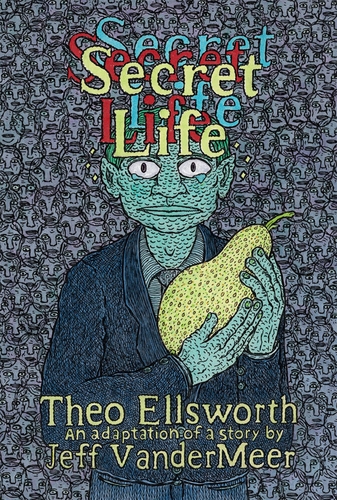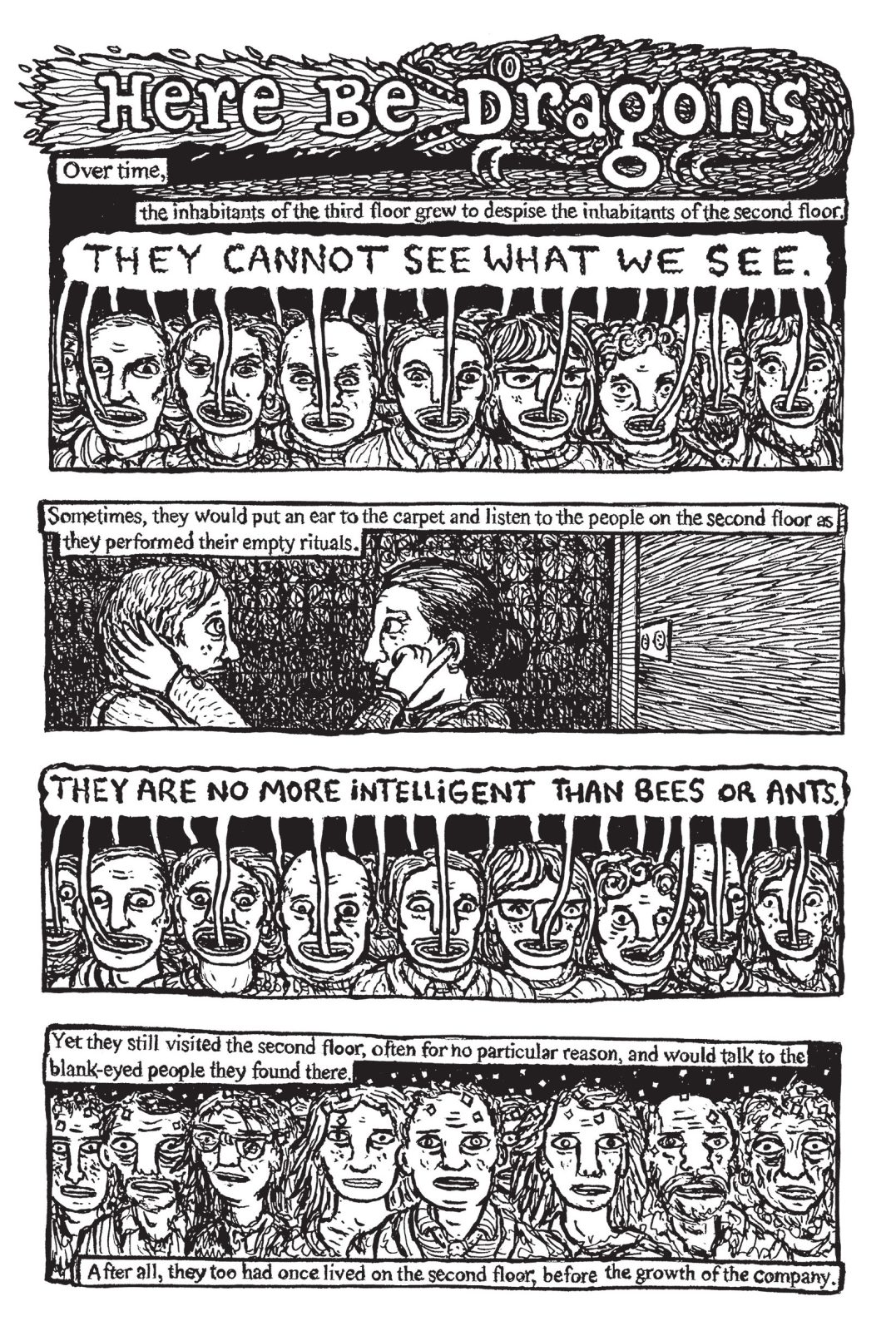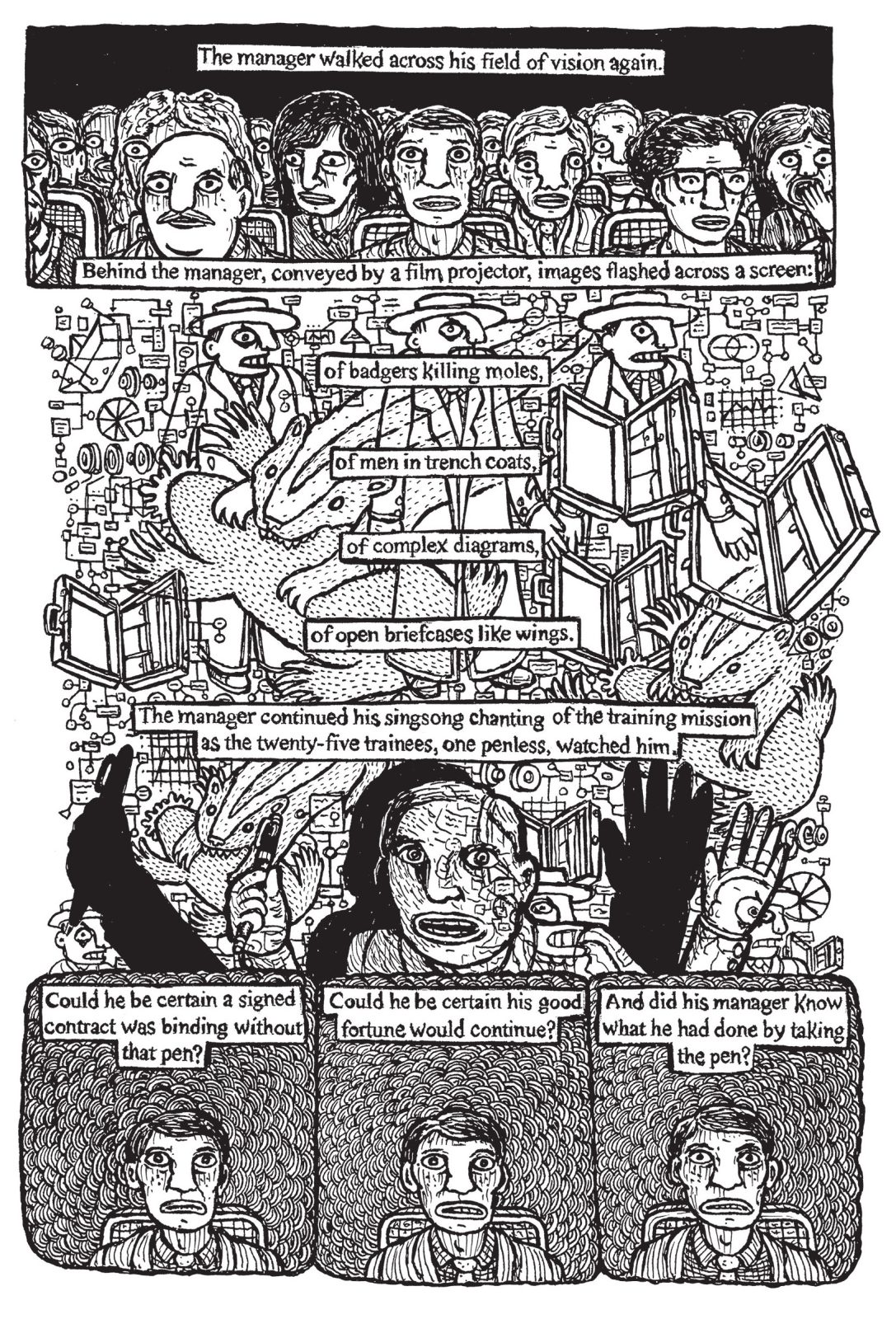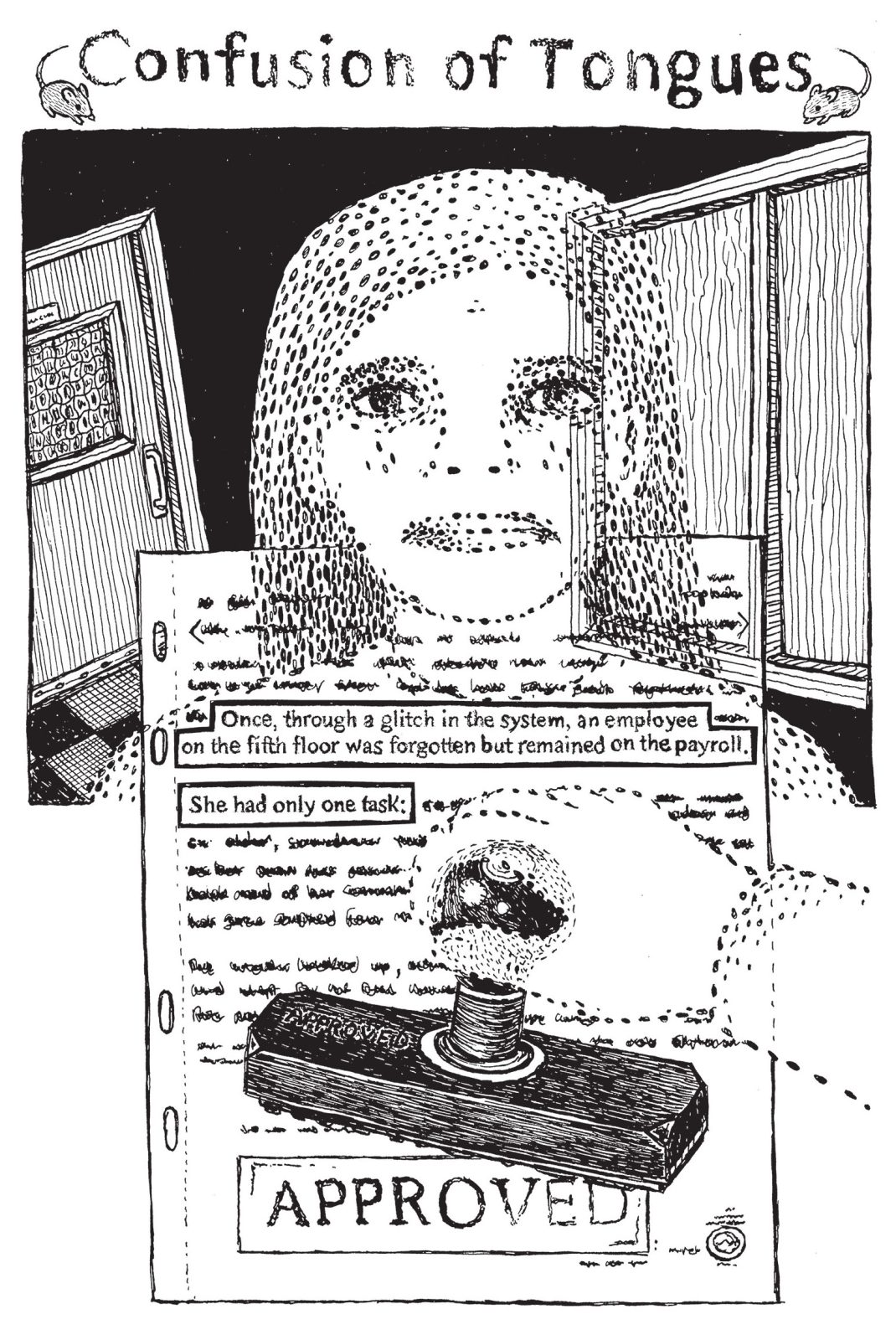How can an adaptation be faithful to the original and a meaningful and innovative departure at the same time? Theo Ellsworth takes Jeff VanderMeer’s short story "Secret Life" absolutely seriously in his comics adaptation: he does not modify the language, and does not add to it at all. He occasionally takes away a few sentences, but very rarely. What we have then, as a result of Ellsworth’s creative intervention, is VanderMeer’s language woven into the panels and lines of the comics version. The upcycling of the text seems so effortless that text, image and design meet almost organically, and a new kind of existence is born. Similarly to the strange plant protagonist of Secret Life—a vine that slowly, steadily, and secretly grows inside the air vents and wire casings of a five-story office building, and by the end overgrows and transforms it—Ellsworth’s lines transform the original story into a new lifeform where there is no point in trying to tell the original components apart.
* * *
Drawing
There is indeed a similarity between VanderMeer’s patient and persistent plant and Ellsworth’s perseverant lines that fill the pages almost compulsively. There is an even rhythm to these lines: the traces of the hand, the mementos of the body’s movement. There is a patience to the thousand tiny strokes used to fill backgrounds or create patterns. This meditative presence of the artist conveyed by these lines is, to my mind, the best adaptation of the secret presence of the lifeform that completely takes over the building. Drawing is very much about transforming thoughts, experience, and movement into lines, and, as many people have said before me, it generates ideas and new questions. I believe that presence and change are equally essential to drawing, and in this respect it is not that difficult (though I admit that it is still uncanny) to recognize how similar drawing is to this irrational, beautiful, dangerous, destructive, growing vine.
Ellsworth’s adaptation gives material form to a central yet hidden theme in VanderMeer’s short story: presence. Both the short story and the graphic novel are about a building and the way it is changed by the vine, and both dwell on the versions of monstrous monotony that the building affords the people who work there. This experience is universal - we see it in the daily practice of the manager and the custodians alike. In fact, one of the basic characteristics of this huge office building is the universality of its absurd practices and a lack of any sense of time or progress. For example, a woman has been forgotten on the payroll and has practically nothing to do, but we also read about secret meetings, and hateful gossip. Interestingly, employees are called inhabitants, and most of them do not leave the premises at all. Similarly, the night custodians do not seem to have a life outside the building: they sleep during the day in cabinets. The manager has a secret dwelling place in his desk. The spectral presence of these inhabitants is felt, even if they are not present.
* * *
Isolation
Most people who have worked for multinational companies (such as myself) have possibly experienced monotony, emptiness, and the aimlessness of the work - and some might have been inspired to turn their experience into horror stories. In VanderMeer’s short story, a detached narrative style emphasizes the experience of alienation; of inhabiting the absurd space of repetitive tasks. The story is made up of short sections, its sentences factual: listing observations of what is going on in the building. There is no change of tone and there are no dialogues. This style is never quite serious, though, as a lot of what is happening is very absurd. As VanderMeer revealed during the online book launch of the graphic novel, parts of the story are based on his actual experience of working for a company at a time when it was bought by another company, and was relocating. The detached tone and the even rhythm of the sentences is kept in the comic adaptation, too, and Ellsworth excels in representing the people working in cubicles, working as couriers, or waiting for the highlight of their days: the lunchbreak.
The beginning of the story perhaps hints that the spatial experience of the building is a kind of a metaphorical structure that enables us to observe society. We read about the mysterious fifth floor, where meetings are held and people might or might not disappear; we also hear about the very competitive third and second floors, and the basement where the custodians collect the used or thrown-away objects of the floors above. Elevators also give the illusion of connection, and later interludes occasionally talk about the vertical movement of employees on the career ladder. In spite of all this, the building is not a hierarchical model; the reader's expectations of getting a social tableau as in Balzac, or pieces of a puzzle as in Rear Window, are false. The second chapter, “Here Be Dragons”, makes it clear that the structure of the building cannot be easily mapped onto the experience of the people, as the latter are defined by limited perspectives and fear of the unknown. Instead of buzzwords like progress, career advancement, and personal progress plans, the building is the place of a universal experience of isolation and limitation. The custodians’ world in the basement is a duplication of their daily practices, as well as the self-justifying beliefs and slogans repeated on the other floors. This is a version of the same structure within the same building.
* * *
Looking in the eyes
Apart from thinking of drawing as a medium of presence (an idea that I also elaborated in my book Comics and the Body), and the structure of the building forcing a certain timelessness on the inhabitants, a further reason why I think that presence is a central topic in this graphic adaptation is that Ellsworth draws the characters in a way that forces the reader look them in the eye. People are often represented looking out of the frames, facing the reader, though not necessarily looking at them. For example, the first panel of the already-mentioned “There Be Dragons” chapter shows eight faces: the employees on the third floor, all but one of them looking down, only one holding eye contact with the reader. These people are only the first line in a crowd of angry employees who hate the people on the second floor, saying in a chorus that “They cannot see what we see.” On the same page, Ellsworth draws a crowd of second-floor people, who are described as “blank-eyed”. They each look the reader in the eye.
The reader is often invited to return helpless or agitated looks; one of the first of these instances involves an employee whose pen got taken by the manager. The manager had grabbed the pen possibly without thinking, but for the employee this feels like being robbed of the memories he associates with his tool. The whole conflict is banal - equally funny and tragic. The employee’s distress (no one has a name in this story) is emphasized by a texturized background surface made out of lines drawn by repetitive gestures: these patterns surround him from panel to panel. This emotionally expressive drawing is contrasted with the images that the manager is projecting during his talk, which also appear on the manager’s skin (as he is standing right in front of the screen). These are seemingly random images “of badgers killing moles, / of men in trench coats, / of complex diagrams, / of open briefcases like wings” - I suspect that the pictures come from a selection offered by the HR department, approved to fit the brand identity and message of the company. We have two characters surrounded by lines and images, and this relationship is far from harmonious in both cases. On the one hand, the employee’s distress is visible in the lines around him; on the other hand, the manager as a living image of the company is characterized by a confusion of boundaries and the disappearance of self - instead of an ideal unity as dreamed by HR departments.
Another beautiful meditation on presence is Ellsworth’s visualization of a chapter called “Confusion of Tongues”, which is about the woman who was forgotten on the payroll. This woman occasionally stamps “Approved” on documents, and spends her days waiting in the confined and windowless space of her office. She is occasionally visited by a courier, but mice who live in the vine—which is growing behind the walls—become her true friends. Ellsworth analyzes this section in detail in the book launch video, stating that, at first, he wanted to show the room from the woman’s point of view, but instead decided to represent the woman as a ghost. Ellsworth is a master of conveying feeling and experience in the eyes that he draws, and when we meet this spectral woman she addresses the reader directly with her eyes. This character does not have clear outlines; her face and body are indicated by dots and circles. She is transparent - she is not fully present at her workplace, nor can she cannot connect to her real self. The mice help her find connection, to find a non-human language, and eventually become a materialized being (drawn in the same style as the other people) instead of a ghost.
* * *
The vine
Though humans are very important in this story, it is not exclusively a story about humans. In both the short story and the comic, the building and the employees on the various floors are described/presented in detail, but the only thing that creates a connection between segments of the building is the mysterious plant growing behind the walls. Similarly to VanderMeer’s other stories and novels, like the Southern Reach Trilogy, this possibly-alien lifeform does not obey any rules of rationality or biological necessity. This specific plant, for example, hates sunlight, lives in symbiosis with several species, and cleans the air in the office. Though I think Ellsworth drew the panels showing people breathing office air that is swarming with exhaling skulls before the COVID pandemic, the current context has given those panels an edge. Looking at these panels can convey a bodily experience of risk.
As the vine grows, it creates a separate ecosystem, and it allows for spatial experiences that are weird in a different way than those enabled by the building. For example, humans disappear in both the building and in the maze of the vine: people vanish without a trace on the fifth floor, and a custodian spends days lost in the maze of the vine. These are, of course, very different (and very weird) bodily experiences, but they are not necessarily opposite. The otherworldly presence of the vine gives “a deep sense of satisfaction” to the custodian, and the glow and hum of the plant is the source of synesthetic experiences. This non-human perception is described as “He felt himself twisting into the vine itself, / so surrounded by vines and flowers that surely they must sprout from him,” visualized by two eyes peeping out of a head made up of flowers. The vine grows behind tiles and in cracks of the walls, and it “colonize[s] the building’s arteries.” This is the only time when the plant’s gradual takeover is described with a metaphor referring to the body. The plant is not (cannot be) judged by human concepts - the chapter title “Liberation” demonstrates that, in spite of its many human characters, the story is not narrated from an anthropocentric point of view. In this chapter, “the vine began to know its own deep green strength” and, in sometimes funny sequences, occupies the whole building. Its spread does not stop here, though.
Humans disappear from the world entirely, but this is not a source of grief. The world is transformed. Huge panels showing the building and the city overgrown by vegetation do not shake or shock us human readers: we know the lines by which they have been drawn. We have been watching, breathing, thinking them in the past 180 pages.












